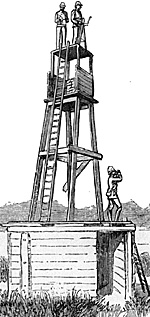 There was good intelligence indicating that
Osman Digna intended to attack the column and small
enemy units had been observed watching its progress.
It is unclear if General McNeill was aware of the
likelihood of such an attack, although unconfirmed
sources indicates that he was less than pleased with
advancing with such a large and cumbersome column.
There was good intelligence indicating that
Osman Digna intended to attack the column and small
enemy units had been observed watching its progress.
It is unclear if General McNeill was aware of the
likelihood of such an attack, although unconfirmed
sources indicates that he was less than pleased with
advancing with such a large and cumbersome column.
The slow moving column was certainly ripe for an attack and the thick scrub which cut down visibility to a matter of yards was further tempting fate.
With such a huge force of men and animals, the use of only two cavalry squadrons and only part of one to act as scouts around the camp was a gross misjudgement. The fact that GenMcNeill kept part of this loan squadron back (presumably one or two troops) tends to indicate his lack of understanding as their usefulness in giving advanced warning of any attack. What he thought this small reserve of Cavalry could achieve if he was attacked is unclear!
It was extremely fortunate for the whole British force that the zeribas were at least partly finished, as the whole force would have been over run by the Mahdist and a tidal wave of stampeding animals.
The Mahdist themselves timed their attack almost perfectly, charging, before the zeribas had been completed, with almost no prior warning being given until they were on top of the camp. It is easy to think that native forces just charged in one mass formation with no control, but this battle clearly shows that a plan had been drawn and adhered to, well apart from the victory that is.
In issue 7 we shall continue the story in the Sudan, but this action dealt a heavy blow to Osman Digna's power, although he still remained a leading player in subsequence events.
WARGAMING MCNEILL'S ZERIBA
We are experimenting with some rules for the Sudan campaign, which cover this sort of action. So for points to note on this battle, we shall leave until issue 5.
We may publish the rules for the campaign soon, at a cost of even the humble Ansar can afford.
Constructing a Zeriba
The Zeriba was a quick and effective form of barricade, using the natural thorny characteristics of the mimosa tree. Attacking forces would think carefully before attempting to breach such a natural barrier.
1. A rope is thrown over the mimosa tree, which is then bent over.
2. One man then chops the tree down at the stem
3. Two men then drag the tree back to camp
4. The stem of the tree is buried in the ground giving the usual height of 4 ft for the Zeriba hedge barrier
5. A two foot deep trench was usually dug behind the hedge, which effectively provided full cover for the defenders.
Zeribas were used as temporary camps.
More McNeill
-
McNeill's Zeriba: Introduction
McNeill's Zeriba: The Battle
McNeill's Zeriba: Battle Profile (Analysis) and Wargaming
Back to Colonial Conquest Issue 4 Table of Contents
Back to Colonial Conquest List of Issues
Back to MagWeb Master List of Magazines
© Copyright 1993 by Partizan Press.
This article appears in MagWeb (Magazine Web) on the Internet World Wide Web.
Other military history articles and gaming articles are available at http://www.magweb.com